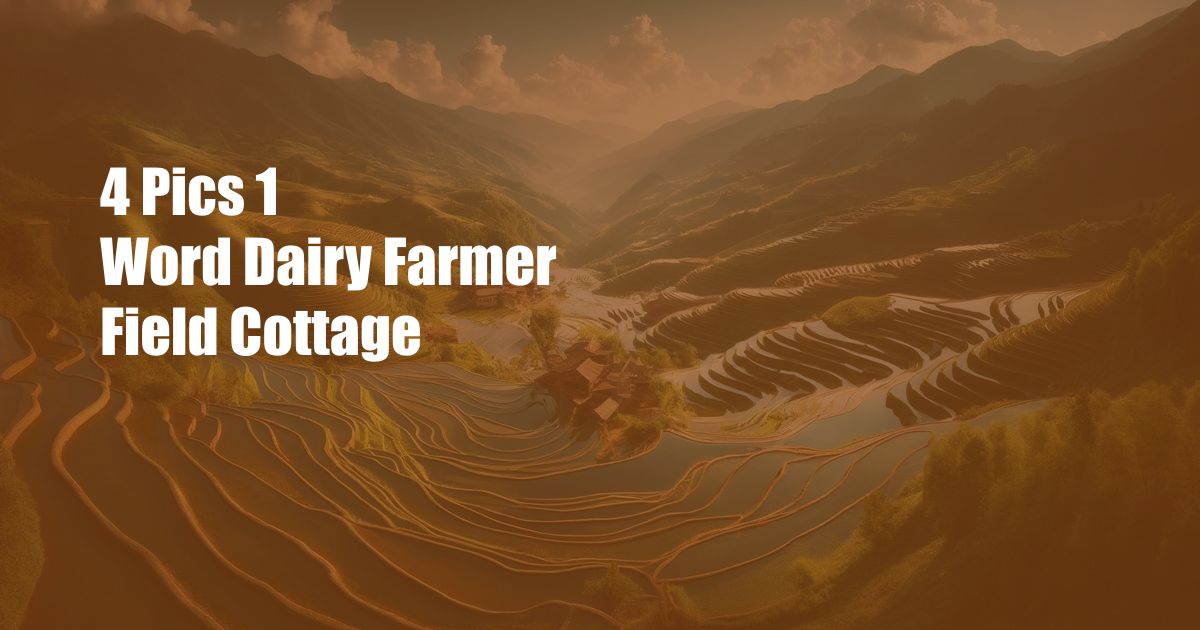
4 Pics 1 Word: Dairy Farmer, Field, Cottage: Uncovering the Rural Life
As a child, I spent summers immersed in the tranquility of my grandparents’ dairy farm, where rolling fields met quaint cottages. The aroma of fresh milk hung in the air, mingling with the sound of contented cows. The simple yet fulfilling life of dairy farming captivated me. Today, let’s revisit this idyllic scene through the lens of “4 Pics 1 Word.”
This captivating word game invites us to decipher a word from four seemingly unrelated images. When the answer eludes us, we often find ourselves drawn into a world of exploration and discovery, unraveling the hidden connections between the images. One such puzzle that piqued my curiosity was the quartet: dairy farmer, field, cottage, and grass.
Dairy Farming: A Tradition Woven Into the Landscape
Dairy farming, an age-old practice, plays a crucial role in sustaining communities and providing nourishment. Dairy farmers nurture herds of cows, tending to their well-being and milking them to obtain milk, a versatile liquid gold. This milk is then processed into a plethora of products, including cheese, butter, and yogurt, forming the foundation of many culinary traditions.
Beyond its nutritional value, dairy farming shapes the very landscape we inhabit. The sprawling fields where cows graze, dotted with fences and barns, evoke a sense of serenity and connection to the land. The cottages that house dairy farmers and their families, often nestled amidst fields, serve as symbols of rural charm and the enduring spirit of agriculture.
Dairy Farming in the Modern Era: Embracing Technology and Sustainability
While the essence of dairy farming remains unchanged, modern advancements have transformed its practices. Dairy farmers now utilize cutting-edge technologies to enhance animal welfare, optimize milk production, and reduce environmental impact. Automated milking systems, for instance, provide cows with greater comfort and flexibility, while data analytics enables farmers to monitor herd health and productivity in real-time.
Sustainability has become an integral part of dairy farming. Farmers implement innovative strategies to reduce their carbon footprint, such as using renewable energy sources, implementing water conservation measures, and adopting regenerative farming practices that improve soil health and biodiversity. These efforts reflect the growing awareness among dairy farmers of their responsibility as stewards of the land.
Expert Advice and Tips for Aspiring Dairy Farmers
Embarking on a dairy farming journey requires careful planning, dedication, and a passion for agriculture. Here are some tips from seasoned dairy farmers:
- Prioritize Animal Welfare: Cows’ well-being is paramount. Provide them with a comfortable living environment, nutritious feed, and access to veterinary care.
- Adopt Sustainable Practices: Implement strategies to reduce environmental impact, such as utilizing renewable energy, conserving water, and practicing regenerative farming.
- Embrace Technology: Utilize technological advancements to enhance efficiency, monitor herd health, and improve milking practices.
- Stay Informed: Keep abreast of industry trends, research, and best practices through workshops, conferences, and networking with other farmers.
- Foster Community Connections: Build relationships with local organizations, veterinarians, and fellow farmers for support and knowledge sharing.
By adhering to these guidelines, aspiring dairy farmers can navigate the challenges and reap the rewards of this noble profession, ensuring the sustainability and prosperity of dairy farming for generations to come.
Frequently Asked Questions about Dairy Farming
Q: What are the main products derived from dairy farming?
A: Dairy farming primarily produces milk, which is then processed into a wide range of products, including cheese, butter, yogurt, ice cream, and various dairy-based beverages.
Q: How does dairy farming contribute to the environment?
A: Dairy farming can impact the environment through greenhouse gas emissions, water consumption, and waste management. However, many farmers are adopting sustainable practices to reduce their environmental footprint, such as utilizing renewable energy, conserving water, and implementing regenerative farming techniques.
Q: What are the challenges faced by dairy farmers today?
A: Dairy farmers encounter various challenges, including fluctuating milk prices, rising production costs, and increasing competition from alternative milk sources. Additionally, they must navigate environmental regulations and adapt to the evolving demands of consumers.
Q: Is dairy farming a viable career path in the modern era?
A: Dairy farming remains a viable career path for individuals with a strong work ethic, passion for agriculture, and a commitment to sustainable practices. It offers opportunities for self-employment, financial stability, and the satisfaction of contributing to the food supply chain.
Conclusion: A Glimpse into the Heart of Rural Life
Through the lens of “4 Pics 1 Word,” we have explored the multifaceted world of dairy farming. From its historical roots to its modern practices, and from its challenges to its rewards, dairy farming paints a vivid portrait of rural life. It is a profession that nourishes both our bodies and our communities, while also preserving the beauty and tranquility of our landscapes.
So, dear readers, I invite you to delve deeper into the world of dairy farming. Visit a local farm, engage with dairy farmers, and savor the flavors of their labor. Let’s appreciate the intricate tapestry of agriculture that sustains our lives and shapes our world.
Are you drawn to the charm and challenges of dairy farming? Share your thoughts and experiences in the comments below.

 Hogki.com Trusted Information and Education News Media
Hogki.com Trusted Information and Education News Media